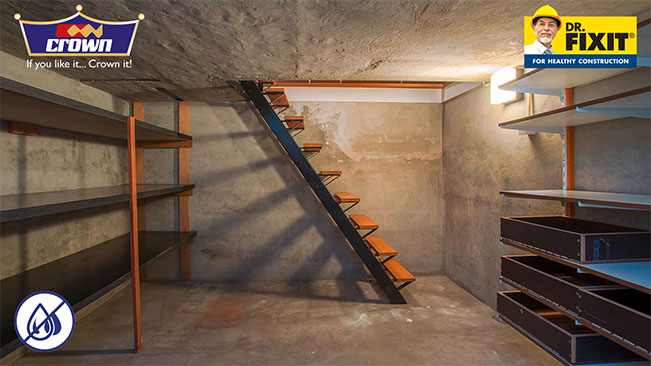
As the cost and availability of real estate increases in urban areas, basements are becoming more and more common in new structures such as high-rise buildings, commercial complexes etc. Basements can provide space for most commercial activities, storage, archives, plant rooms or car parking. In residentials, they provide valuable additional space, which can be efficiently heated and is particularly useful for leisure activities with different games rooms, storage and parking without increasing the height of the building.
A basement is one (shallow) or more floors (deep) of a building that are either completely or partially below the ground floor. Waterproofing and drainage considerations are especially important in cases where groundwater is likely to build up in the soil or where there is a high water table. Water in the soil causes hydrostatic pressure to be exerted underneath basement floors and walls. This hydrostatic pressure can force water in through cracks, which can cause major structural damage as well as mould, decay, and other moisture-related problems.
The design and the construction procedures required to complete basement waterproofing are more important than waterproofing the basement itself. The term “basement waterproofing” is intended to encompass the topic of moisture protection and protection from all undesirable liquids and gases as applied to a variety of existing below-grade structures. Basement waterproofing involves techniques and materials used to prevent water from penetrating the basement of a house or a building.
While selecting any waterproofing material for a basement, one must consider the water table level, major functional properties required such as hydrostatic pressure head to resist, presence of aggressive chemicals if any, required internal dryness and service life of the waterproofing system. The thickness of the coating/membrane and other properties need to be selected based upon their required performances of the waterproofing systems.
Types of Waterproofing Methods
There are three types of basement waterproofing usually adopted;
- Barrier protection where the basement is tanked from outside, inside or both with a liquid-applied coating or a membrane.
- Structurally integral system; where the structure itself is made watertight by selecting suitable materials and designs.
- Drained cavity protection system where drainage with a pumping arrangement is provided.
Based on the importance of the usable area and internal dryness required, the basement can be designed as per any one of the above methods or a combination of any two or all the systems.
In Kenya, for waterproofing of basements, the widely used or preferred systems are APP Bituminous membrane and Crystalline system.
This article focuses on Atactic Poly Propylene (APP) Bituminous membranes v/s High-Density Polyethylene (HDPE) membranes.
Let us go through the pros and cons of torch-applied Atactic Poly Propylene (APP) Bituminous membranes.
Pros:
- Have been used for over 50 years now
- Easily Available
- Moderately priced and manufacturers offering warranties for 10 years
Cons:
- The APP-modified bitumen application process is complicated
- The temperature and product consistency must be just right for a successful installation
- Vertical wall waterproofing applications are critical and cumbersome
- All fire safety precautions to be carried out on site
- Major failures at overlapping joints and corners, hence, need more attention at these areas
- Not a fully bonded system, as the membrane is never in contact with the mother concrete/raft slab
HDPE is the best material for waterproofing for basements with a high or variable water table, which is applied as loose lay. HDPE is a fully bonded membrane that bonds to the wet concrete cast on the membrane. After the membrane bonds with the concrete, it forms an integral seal which prevents lateral water migration and makes it unaffected by any substrate settlement below the slabs. Reinforcement can be directly laid on top of the membrane and it does not require screed protection.
Dr Fixit Prebond is a unique HDPE membrane comprising of a virgin HDPE layer and a pressure-sensitive adhesive layer which is covered by a weatherproof protective layer. The adhesive layer is activated when the concrete is poured on the membrane and it enables the membrane bond to the underside of the concrete which prevents the ingress of water into the structure as well as prevents tracking of water between the membrane and the structure and provide positive side protection against ingress of subsoil water. Dr Fixit Prebond can be used for horizontal as well as vertical blindside application.
Typical Application
- Basement
- Subway and UG metro project
- Cut and cover tunnels
- Caverns
- Other underground civil structures
Benefits
- High tensile strength: 21 Mpa
- Very good cold temperature flexibility (-25°C)
- Fully bonded to the structure
- High adhesion to concrete (880 N/m)
- Puncture Resistant > 800 N
- Does not allow any moisture movement






